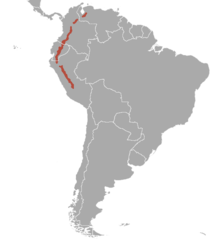North Pudu
| North Pudu | ||||||||||||
|---|---|---|---|---|---|---|---|---|---|---|---|---|

Northern Pudu ( Pudu mephistophiles ) |
||||||||||||
| Systematics | ||||||||||||
|
||||||||||||
| Scientific name | ||||||||||||
| Pudu mephistophiles | ||||||||||||
| ( de Winton , 1896) |
The northern pudu ( Pudu mephistophiles ) is the smallest species of deer found in America .
Appearance
The northern pudu has a head-torso length of 60 to 74 centimeters and a shoulder height between 25.0 and 40.5 centimeters. There are no differences in body size between males and females. This makes the North Pudu a little smaller than the South Pudu . Its head is 12.7 to 14.2 inches long. The tail is very short at 3 to 4 centimeters. The weight is only 3 to 6 kilograms. It has short, slender legs, a rounded back and antlers that are reminiscent of two small horns and are 6 to 9 centimeters long. The fur is reddish brown, towards the back increasingly dark brown or blackish. The head is black. The inner surfaces of the rounded ears are gray-white to gray. The belly and the insides of the legs are reddish brown. The fur is short and dense. The hooves appear narrow and pointed.
Occurrence
The species occurs in the humid forests, swamp areas and in the open páramo grasslands above the tree line of the northern Andes at an altitude of 1700 to 4500 meters from the Cordillera Central in southern Colombia via the Cordillera Oriental in Ecuador to the cloud forests of the eastern Andes and south to the central Peruvian region of Junín . The inhabited landscapes are diverse, but generally characterized by a humid climate with sometimes frosty nights and precipitation in the form of rain, snow and fog. The original natural range was divided by a depression overgrown with dry forest in the northern Peruvian province of Huancabamba into a northern area with about 60,000 to 95,000 km² and a southern area with 30,000 to 35,000 km². Today the living space has been further divided by human influences. A stable population may exist. a. in the northern Peruvian national park Río-Abiseo .
Way of life
The Northern Pudu is crepuscular and nocturnal. However, there are only a few observations of the shy animals, so activities during the day are also conceivable. The species mostly lives solitary, but pairs have been observed occasionally. It is not known whether the northern pudu is a strictly territorial animal. Its physique allows long jumps, so that it can escape possible enemies in quick zigzag jumps like the duckers . It feeds on leaves, young shoots and fruits of various trees. According to local residents, he also climbs trees to get fruit. In addition, he sometimes stays in arable areas to eat.
Reproduction
Little is known about reproduction, but the less seasonal climate of the central Andes does not depend on the seasons . There may be two mating seasons per year, once from August to September and then from March to April. After a gestation period of seven months, a young of about 400 g body weight is born with no stains on its fur. This is premature and reaches the size of the adult animals after around six months.
Hazards and protective measures
The northern pudu was particularly heavily hunted from the 1950s to 1980s. Nowadays, feral domestic dogs and the destruction of their habitat represent the greatest threats. The IUCN lists them as endangered ( vulnerable ). To protect the species, protected areas were designated and hunting restrictions were introduced. In addition, several research projects are ongoing to clarify further protective measures for this species.
swell
- The great world empire of the animals . Planet Media AG, Zug 1992, pp. 138, 139, ISBN 3-8247-8614-1
- Encyclopedia of Mammals . Könnemann, 2003, pp. 504-519, ISBN 3-89731-928-4
Individual evidence
- ↑ a b L. Escamilo, J. Barrio, J. Benavides and D. Tirira: Northern pudu Pudu mephistophiles (De Winton 1896). In: JMB Duarte and S. Gonzalez: (Eds.): Neotropical Cervidology: Biology and Medicine of Neotropical Deer. FUNEP, Jaboticabal, Brazil and IUCN , Gland, Switzerland, 2010, pp. 133-139 PDF
- ↑ a b c d e S. Mattioli: Family Cervidae (Deer). In: Don E. Wilson and Russell A. Mittermeier (eds.): Handbook of the Mammals of the World. Volume 2: Hooved Mammals. Lynx Edicions, Barcelona 2011, ISBN 978-84-96553-77-4 , p. 438
- ↑ J. Barrio and D. Tirira: Pudu mephistophiles. In: IUCN 2013. IUCN Red List of Threatened Species. Version 2013.1. ( [1] ), last accessed on October 8, 2013
Web links
- Pudu mephistophiles inthe IUCN 2012 Red List of Threatened Species . Listed by: Barrio, J. & Tirira, D., 2008. Retrieved June 13, 2013.
